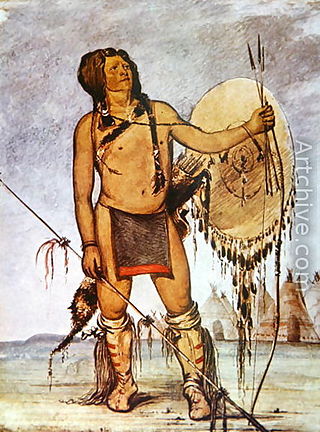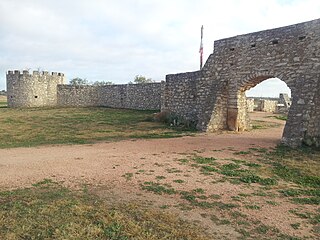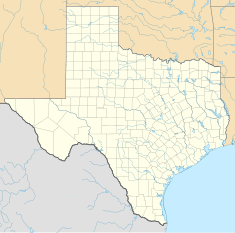
Jefferson County is a county located in the U.S. state of Oklahoma. As of the 2020 census, the population was 5,337. Its county seat is Waurika. The county was created at statehood and named in honor of President Thomas Jefferson.

Quanah Parker was a war leader of the Kwahadi ("Antelope") band of the Comanche Nation. He was likely born into the Nokoni ("Wanderers") band of Tabby-nocca and grew up among the Kwahadis, the son of Kwahadi Comanche chief Peta Nocona and Cynthia Ann Parker, an Anglo-American who had been abducted as a nine-year-old child and assimilated into the Nokoni tribe. Following the apprehension of several Kiowa chiefs in 1871, Quanah Parker emerged as a dominant figure in the Red River War, clashing repeatedly with Colonel Ranald S. Mackenzie. With European-Americans hunting American bison, the Comanches' primary sustenance, into near extinction, Quanah Parker eventually surrendered and peaceably led the Kwahadi to the reservation at Fort Sill, Oklahoma.
Lipan Apache are a band of Apache, a Southern Athabaskan Indigenous people, who have lived in the Southwest and Southern Plains for centuries. At the time of European and African contact, they lived in New Mexico, Colorado, Oklahoma, Texas, and northern Mexico. Historically, they were the easternmost band of Apache. Early adopters of horse culture and peyotism, the Lipan Apache hunted bison and farmed.

The Wichita people or Kitikiti'sh are a confederation of Southern Plains Native American tribes. Historically they spoke the Wichita language and Kichai language, both Caddoan languages. They are indigenous to Oklahoma, Texas, and Kansas.

The Comanche Wars were a series of armed conflicts fought between Comanche peoples and Spanish, Mexican, and American militaries and civilians in the United States and Mexico from as early as 1706 until at least the mid-1870s. The Comanche were the Native American inhabitants of a large area known as Comancheria, which stretched across much of the southern Great Plains from Colorado and Kansas in the north through Oklahoma, Texas, and eastern New Mexico and into the Mexican state of Chihuahua in the south. For more than 150 years, the Comanche were the dominant native tribe in the region, known as “the Lords of the Southern Plains”, though they also shared parts of Comancheria with the Wichita, Kiowa, and Kiowa Apache and, after 1840, the southern Cheyenne and Arapaho.

The Comancheria or Comanchería was a region of New Mexico, west Texas and nearby areas occupied by the Comanche before the 1860s. Historian Pekka Hämäläinen has argued that the Comancheria formed an empire at its peak, and this view has been echoed by other non-Comanche historians.

The Tonkawa are a Native American tribe indigenous to present-day Oklahoma. Their Tonkawa language, now extinct, is a linguistic isolate.

Spanish Texas was one of the interior provinces of the colonial Viceroyalty of New Spain from 1690 until 1821. The term "interior provinces" first appeared in 1712, as an expression meaning "far away" provinces. It was only in 1776 that a legal jurisdiction called "Interior Provinces" was created.

The Spanish Missions in Texas comprise a series of religious outposts established by Spanish Catholic Dominicans, Jesuits, and Franciscans to spread the Catholic doctrine among area Native Americans, but with the added benefit of giving Spain a toehold in the frontier land. The missions introduced European livestock, fruits, vegetables, and industry into the Texas area. In addition to the presidio and pueblo (town), the misión was one of the three major agencies employed by the Spanish crown to extend its borders and consolidate its colonial territories. In all, twenty-six missions were maintained for different lengths of time within the future boundaries of the state of Texas.

Comanche history is the story of the Native American (Indian) tribe which lived on the Great Plains of the present-day United States. In the 17th century the Eastern Shoshone people who became known as the Comanche migrated southward from Wyoming. In the 18th and 19th centuries the Comanche became the dominant tribe on the southern Great Plains. The Comanche are often characterized as "Lords of the Plains." They presided over a large area called Comancheria which they shared with allied tribes, the Kiowa, Kiowa-Apache, Wichita, and after 1840 the southern Cheyenne and Arapaho. Comanche power and their substantial wealth depended on horses, trading, and raiding. Adroit diplomacy was also a factor in maintaining their dominance and fending off enemies for more than a century. They subsisted on the bison herds of the Plains which they hunted for food and skins.
Jean-Baptiste Bénard de la Harpe was a French explorer who is credited with using the name "Little Rock" in 1722 for a stone outcropping on the bank of the Arkansas River used by early travelers as a landmark. Little Rock, Arkansas was subsequently named for the landmark.
The Texas–Indian wars were a series of conflicts between settlers in Texas and the Southern Plains Indians during the 19th-century. Conflict between the Plains Indians and the Spanish began before other European and Anglo-American settlers were encouraged—first by Spain and then by the newly Independent Mexican government—to colonize Texas in order to provide a protective-settlement buffer in Texas between the Plains Indians and the rest of Mexico. As a consequence, conflict between Anglo-American settlers and Plains Indians occurred during the Texas colonial period as part of Mexico. The conflicts continued after Texas secured its independence from Mexico in 1836 and did not end until 30 years after Texas became a state of the United States, when in 1875 the last free band of Plains Indians, the Comanches led by Quahadi warrior Quanah Parker, surrendered and moved to the Fort Sill reservation in Oklahoma.

Mission Santa Cruz de San Sabá was one of the Spanish missions in Texas. It was established in April 1757, along with the Presidio San Luis de las Amarillas, later renamed Presidio of San Sabá, in what is now Menard County. Located along the San Saba River, the mission was intended to convert members of the Lipan Apache tribe. Although no Apache ever resided at the mission, its existence convinced the Comanche that the Spanish had allied with the Comanche's mortal enemy. In 1758 the mission was destroyed by 2,000 warriors from the Comanche, Tonkawa, Yojuane, Bidai and Hasinai tribes. It was the only mission in Texas to be completely destroyed by Native Americans. The Indians did not attack the nearby presidio.

Presidio San Luis de las Amarillas, now better known as Presidio of San Sabá, was founded in April 1757 near present-day Menard, Texas, United States to protect the Mission Santa Cruz de San Sabá, established at the same time. The presidio and mission were built to secure Spain's claim to the territory. They were part of the treaty recently reached with the Lipan Apaches of the area for mutual aid against enemies. The early functioning of the mission and presidio were undermined by Hasinai, also allied with the Spanish, attacking the Apaches. The mission was located three miles downstream from the presidio by request of the monks at the mission to ensure that the Spanish soldiers would not be a corrupting influence on the Lipan Apaches the monks were trying to convert to Christianity. The original presidio and mission were built out of logs.
The Taovaya tribe of the Wichita people were Native Americans originally from Kansas, who moved south into Oklahoma and Texas in the 18th century. They spoke the Taovaya dialect of the Wichita language, a Caddoan language. Taovaya people today are enrolled in the Wichita and Affiliated Tribes, a federally recognized tribe headquartered in Anadarko, Oklahoma.

The Comanche–Mexico Wars was the Mexican theater of the Comanche Wars, a series of conflicts from 1821 to 1870. The Comanche and their Kiowa and Kiowa Apache allies carried out large-scale raids hundreds of miles deep into Mexico killing thousands of people and stealing hundreds of thousands of cattle and horses. The Comanche raids were sparked by the declining military capability of Mexico during the turbulent years after it gained independence in 1821, as well as a large and growing market in the United States for stolen Mexican horses and cattle.
Don Pedro de Rábago y Terán was a Spanish administrator and military officer in New Spain, now Mexico. He was governor of Coahuila from August 1744 to June 1754. In 1754, Don Pedro de Rábago y Terán was sent by the viceroy of New Spain to find a site for an Apache Mission, named a pass between the hills in Menard County overlooking the San Saba River as Puerto de Baluartes. The Santa Cruz de San Sabá Mission was established three years later on the San Saba River near Menard, Texas. As an explorer in the late 1740s he went on three expeditions to the confluence of the Rio Grande and the Rio Conchos, known as La Junta de los Rios, in order to establish a presidio or military camp to serve six missions in the area of La Junta, which were being attacked by the Apache. He recommended a site that became the Presidio de la Junta de los Ríos Norte y Conchos near what is now Presidio, Texas.

The Presidio of San Sabá was the second presidio established at the site of present-day Menard, Texas on the San Saba River. The first was the Presidio San Luis de las Amarillas, established by Colonel Diego Ortiz Parrilla in April 1757, the same time that Mission Santa Cruz de San Sabá was also founded by Fr. Alonso Giraldo de Terreros some three miles downstream. Initially, both the presidio and mission were enclosed by a wooden stockade. About 2,000 Comanche and Wichita warriors attacked and destroyed the mission March 16, 1758, but did not attack the presidio. Colonel Parrilla led a punitive expedition against the hostiles about one year later, but was defeated in the Battle of the Twin Villages at a large Wichita village on the Red River. Colonel Parrilla was relieved of command as a consequence of this setback and replaced by Captain Felipe de Rábago y Terán.
Pedro Vial, or Pierre Vial, was a French explorer and frontiersman who lived among the Comanche and Wichita Indians for many years. He later worked for the Spanish government as a peacemaker, guide, and interpreter. He blazed trails across the Great Plains to connect the Spanish and French settlements in Texas, New Mexico, Missouri, and Louisiana. He led three Spanish expeditions that attempted unsuccessfully to intercept and halt the Lewis and Clark Expedition.
Diego Ortiz Parrilla was an 18th-century Spanish military officer, governor, explorer, and cartographer.















